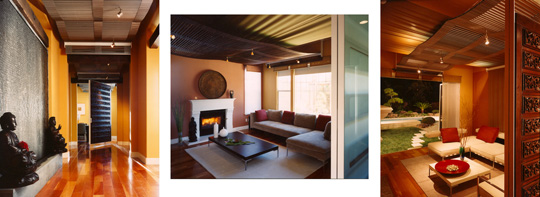Contemportary living spaces located close to or on the waterfront are gaining in popularity: loft-living and hi-rising real estate in neighborhoods on the edge of the Bay are a bourgeoning reality. Since our environment affects our quality of life, we begin our focus on Waterfront Living. This month, we feature Logue Studio Design - an award-winning San Francisco design firm that specializes in contemporary residential and commmercial design. modern architechture does not have to be sparce. The inside can match the beauty of the views of the Bay and the hills outside.

Published: January, 2006
The Nguyen Residence Ė Los Gatos, CA
Contemportary living spaces located close to or on the waterfront are gaining in popularity: loft-living and hi-rising real estate in neighborhoods on the edge of the Bay are a bourgeoning reality. Since our environment affects our quality of life, we begin our focus on Waterfront Living. This month, we feature Logue Studio Design - an award-winning San Francisco design firm that specializes in contemporary residential and commmercial design. modern architechture does not have to be sparce. The inside can match the beauty of the views of the Bay and the hills outside.
By Michael Logue
The Nguyen Residence is a 3000 sq. ft. California ranch-style home. The clientís deep appreciation for both, Pan Pacific art and architecture as well as contemporary design, were integrated into the design as an abstraction of the Balinese Hut. Color, texture, materials, finishes and cultural influences all became major points of interest in the initial design of the space.
The design intent involved creating a design vocabulary that linked separate parts of the home, using both Asian and contemporary languages. To achieve this spatial link, a series of ceiling canopies were developed that interconnect different areas of the home. Walnut dowel canopies and a stainless steel version reference and abstract the feeling of the interior of an Indonesian thatched dwelling as well as a canopy of trees. Additional colored fabric canopies are hung above the wooden and metal counterparts and define the major rooms. The interiorís color scheme evolved from the rich and vibrant colors seen in traditional Pan Pacific design while also referencing the natural environment. For example, the orange hues of the entry represent Fire, the green fabric and wood canopies of the family room represent Earth while the blue fabric and stainless steel canopies of the living room represent Air. Each space is meant to flow into adjacent spaces. Canopies turn corners; wall and ceiling paints also slip from one surface to another in a way as to suggest an ongoing movement within the home. In introducing both fixed and active elements, as well as rustic and contemporary materials, a dynamic spatial balance is achieved within the interior.
Michael F.D. Logue, Principal of Logue Studio Design, was born in Chicago, IL in 1966. He holds a Bachelors of Science in Design from the University of Cincinnatiís Interior Architecture program and a Masters of Architecture from Columbia University, NY. He studied Design with an emphasis on Industrial Design at the University of Copenhagen, Denmark and completed a joint yearlong program in Traditional Japanese Architecture at Kyoto University and Kyoto Architectural College. In addition, Mr. Logue completed a yearlong apprenticeship under a Master Carpenter of Temple and Shrine construction in Kyoto, Japan. Logue Studio Designís recent client work includes several contemporary homes, and The DeYoung Art Center for the Fine Arts Museums of San Francisco. www.loguestudiodesign.com

